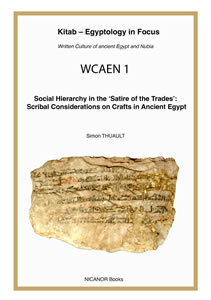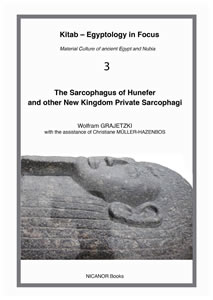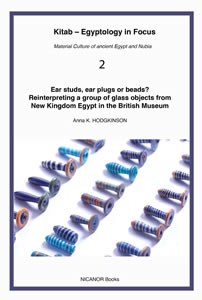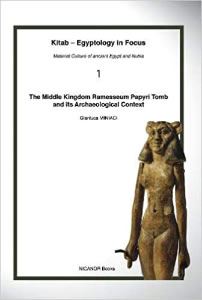Kitab series - guidelines for authors - click here (PDF) |
Simon Thualt Social Hierarchy in the WCAEN 1 88 pages, 23 figures ISBN 978-1-8381180-6-8 This short study of how the various trades of the Teaching of Khety are described and how they are depicted in other sources show that the contents of the Satire are mostly focused on tasks and gestures not always relevant regarding actual chaînes opératoires, but useful in order to convey the global emphasis of the text. |
Wolfram Grajetzki The Sarcophagus of Hunefer and other New Kingdom Private Sarcophagi (Kitab - Egyptology in Focus) Kitab 3 102 pages, colour images ISBN 978-1-8381180-2-0 £35 - $70 This is the publication of the sarcophagus of the mayor of Thebes, Hunefer, in office under Ramses II. To date, the granite sarcophagus in the Fitzwilliam Museum in Cambridge has received little research attention despite being a large scale monument. The book provides a presentation of the sarcophagus and its place in space and time. |
Anna K. Hodgkinson Ear studs, ear plugs or beads? Reinterpreting a group of glass objects from New Kingdom Egypt in the British Museum (Kitab - Egyptology in Focus) 74 pages, colour images ISBN 978-1-8381180-2-0 £25 - $50 This short volume discusses a group of glass objects kept in the British Museum that date to the Egyptian New Kingdom (1550–1069 BC) and are commonly referred to as 'ear plugs' or 'ear studs'. Ancient Egyptian ear studs from variety of materials appear in the archaeological record and are usually depicted as worn with a convex dome to the front. However, there is evidence to suggest that the glass objects discussed in this volume, and which are similar, but not equal, in shape to ear studs, were not designed as ear jewelery, but that they actually functioned as beads. The objects are flat-fronted and pierced latitudinally. The piercing, which is related to the manufacture of the objects on a metal rod,would have enabled the objects to be threaded and to be suspended vertically, either as parts of garments or as parts of bead chains. |
Gianluca Miniaci The Middle Kingdom Ramesseum Papyri Tomb and its Archaeological Context (Kitab - Egyptology in Focus) Kitab 1 128 page. hard cover, over 40 colour images ISBN 978-1838118006 £45 - $90 In 1895–96, William Matthew Flinders Petrie and James Edward Quibell discovered a shaft-tomb below the ‘Ramesseum', the funerary temple of Ramses II at Thebes, Egypt. This is most famous for having the largest group of Middle Kingdom papyri – also known as the Ramesseum Papyri – found in a single spot together with a number of distinctive objects, such as carved ivory tusks and miniature figurines in various materials dated around XVIII century BC. Gianluca Miniaci attempts to thoroughly reconstruct the archaeological context of the tomb: the exact find spot (forgotten afterwards its discovery), its architecture, the identity of its owner(s) and recipient(s) of the assemblage of artefacts. A detailed analysis of the single artefacts – provided for the first with full color photographic records and drawings – and their network of relations gives new life to the Ramesseum assemblage after more than a century from its discovery. |




